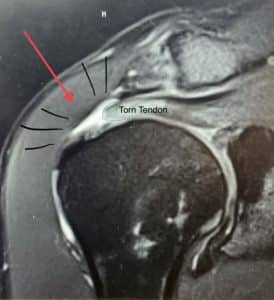
You may have had a visit with a doctor, physical therapist, chiropractor, or orthopedic surgeon recently and learned that you have rotator cuff tear. Or perhaps you had an MRI or ultrasound exam that found a rotator cuff tear.
In addition to wondering what to do next, you probably also want to know how it happened.
Rotator cuff tears are usually divided into 2 separate groups. The first group, which is certainly the most common and largest group, is called “degenerative” or simply “wear and tear.” As you see with other parts of your body as you age, including your skin and your spine, muscles and tendons go through wear and tear changes over the years. Some of this may include activity related changes, such as overuse and repetitive motions, some of these are more genetic and “hereditary” changes much like male pattern hair loss. These changes add up over time and lead to fraying and minor tearing, which over the years may add up to more advanced tearing of the rotator cuff.
Scientists have looked at larger populations of patients and found that first and second-degree relatives of patients with rotator cuff tears are much more likely to have rotator cuff tears themselves.
We do know from scientific studies that the older you are, the more likely you are to have a rotator cuff tear. One study showed that 25% of patients aged 60 or older have rotator cuff tears, while over 50% of patients over age 80 have rotator cuff tears. Of course, these include probably many tears that did not cause pain or symptoms, but you get the point.
The second group, which is smaller and less common, is called “traumatic” or more sudden onset, injury related rotator cuff tears. These are easier to understand from a medical and scientific standpoint. Simply put, the muscle and tendon of the rotator cuff are torn from the arm bone by a sudden injury at a specific point in time that is usually felt by the patient. Perhaps the patient had a bad car or motorcycle accident, or was lifting something very heavy and felt a “pop” followed by weakness and pain.
The final point to keep in mind is that many rotator cuff tears may be partially degenerative and age-related and partially traumatic or injury-related. There is certainly overlap, and multiple factors can work together to create a rotator cuff tear.
Regardless of why or how it happened, it is important that shoulder specialist be involved in your decision-making regarding how to treat your rotator cuff tear. Whether it includes physical therapy, chiropractic care, home exercise program, injections, oral anti-inflammatory medications, or repairing the rotator cuff with arthroscopic surgery, Dr. Johnny T. Nelson, Raleigh Upper Ex, and The Bone & Joint Surgery Clinic are here for you.
Visit our Rotator Cuff Tear information page for more information.
References:
Hsu J, Keener JD. Natural History of Rotator Cuff Disease and Implications on Management. Oper Tech Orthop. 2015 Mar 1;25(1):2-9. doi: 10.1053/j.oto.2014.11.006. PMID: 26726288; PMCID: PMC4695395.


